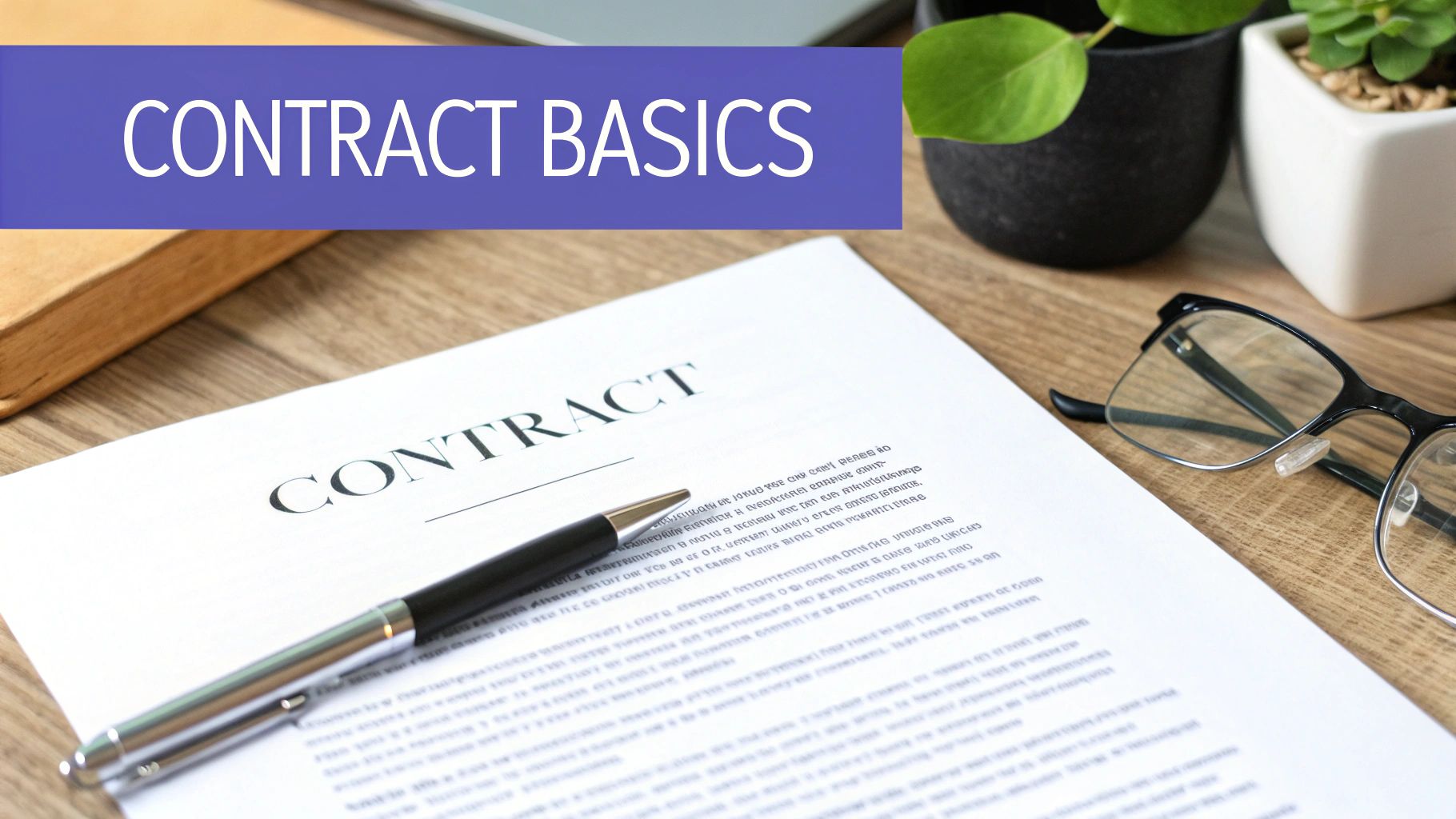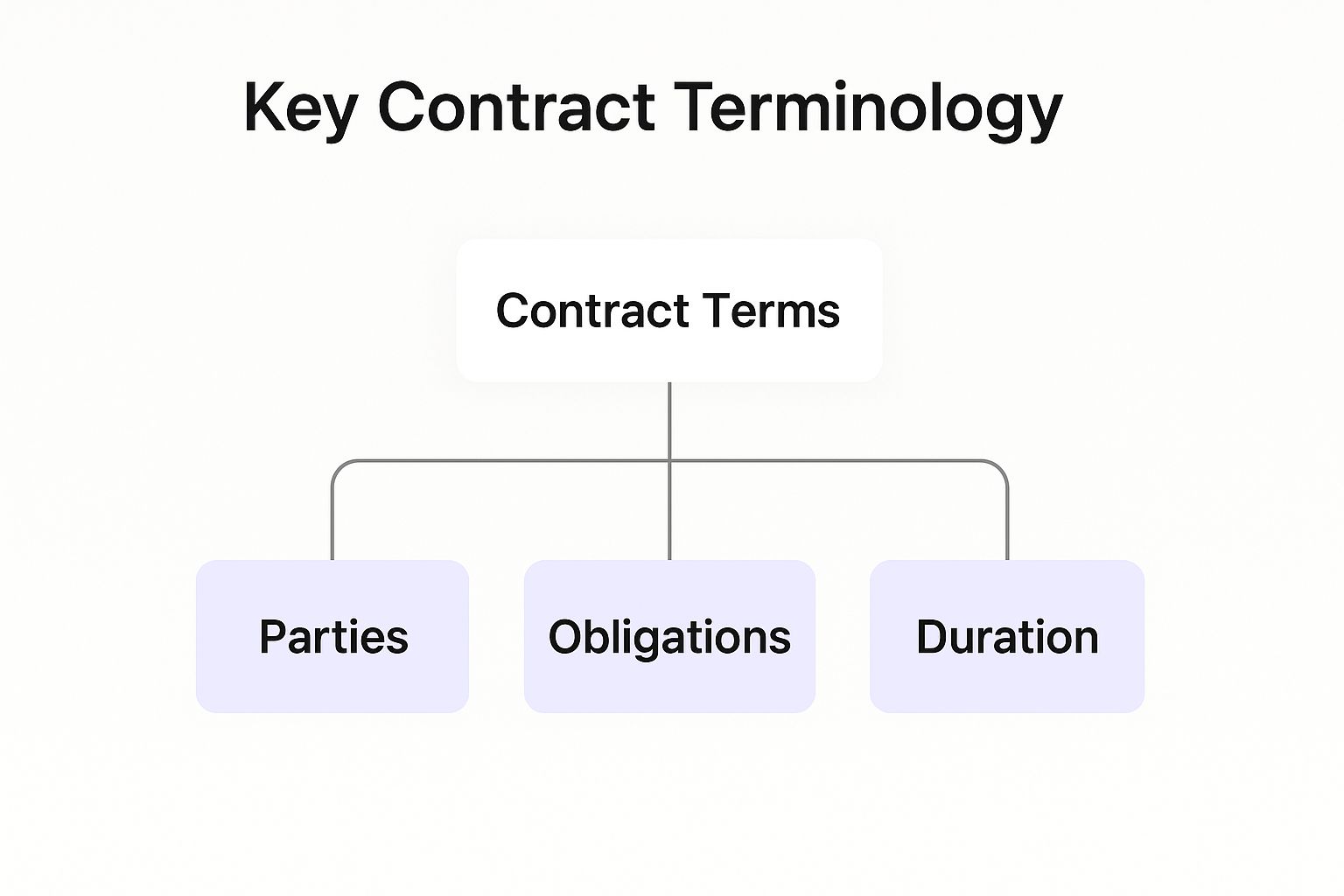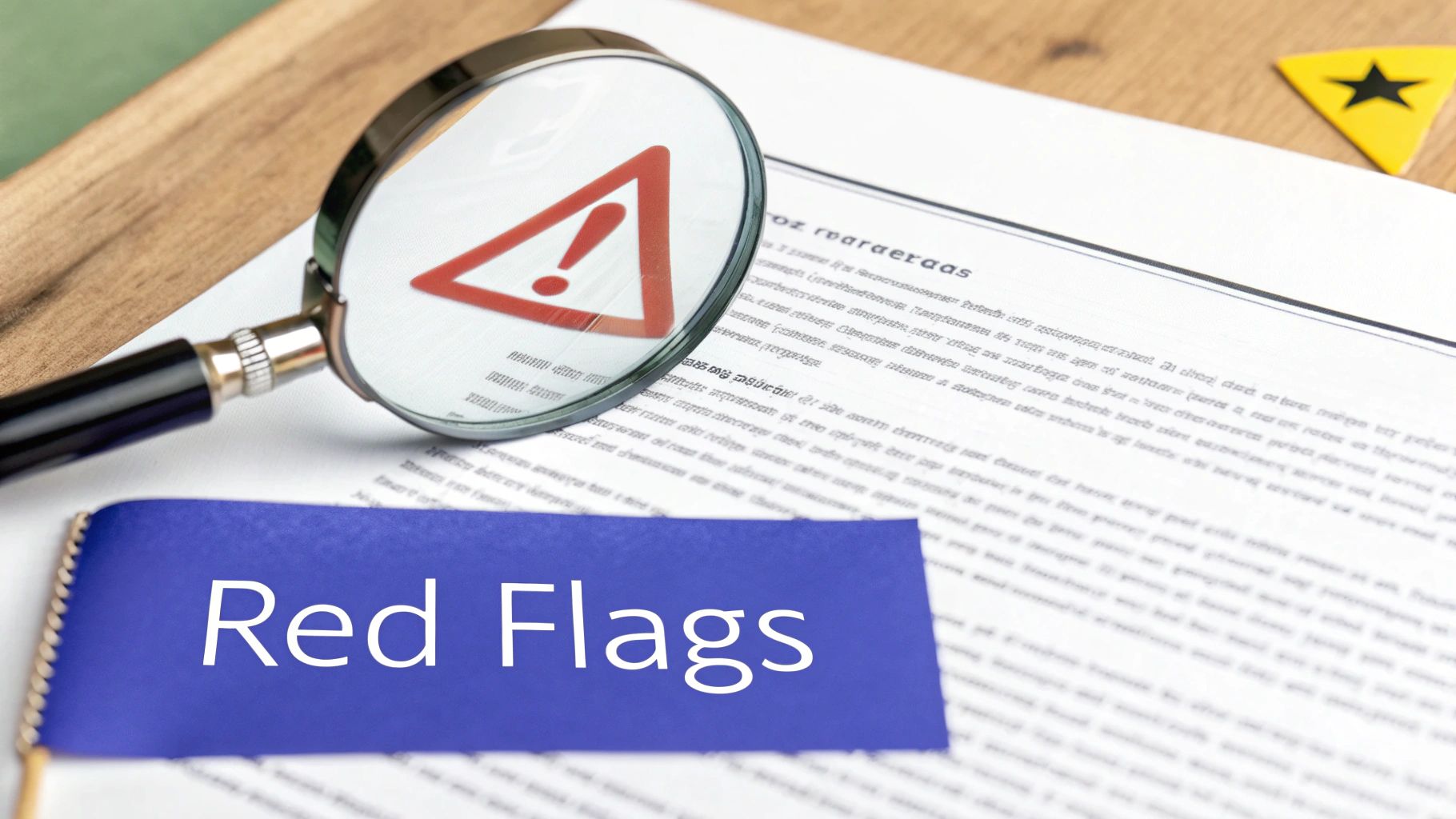
Let's be honest: reading a contract can feel like a high-stakes guessing game. For most of us, it is. The real secret to understanding contracts is shifting your mindset. You need to go from feeling intimidated to feeling empowered. This starts by learning to spot common patterns, zeroing in on critical clauses like payment and termination, and never being afraid to question vague language before you put pen to paper.
Why We Sign Contracts We Don't Understand

We’ve all been there. A dense document, swimming in legalese, lands in your inbox. It could be for a new freelance gig, a gym membership, or just updated software terms. The pressure to just sign it and get on with your day is enormous. If you've ever felt that way, you're definitely not alone.
That mix of anxiety and urgency pushes us to take mental shortcuts. We tell ourselves the terms are probably standard, or we assume the other person has our best interests at heart. Sometimes, we just feel like we don’t have the time or legal know-how to pick it all apart. The truth is, the complexity of these documents is designed to be overwhelming—it’s not a personal failing on your part.
The Scope of the Problem
This isn't just a feeling; it's a widespread issue. One revealing study found that a staggering 68% of people either don’t read or don’t fully understand the contracts they sign for everyday things like phone plans or subscriptions. Even more concerning, over a third admitted they rarely (or never) bother to check updated terms for contracts that auto-renew. You can dig into these findings on The University of Law's website.
This "sign now, read later" (or never) habit is a recipe for disaster. It can lead to everything from surprise fees and hidden penalties to getting locked into a terrible long-term commitment you can't escape.
This is exactly how critical details slip through the cracks. A freelance agreement might sneak in a clause that makes you liable for almost anything, or that new gym membership could have a tricky auto-renewal policy with a huge cancellation fee buried deep in the fine print.
Before you dive into the details, use this quick guide to get your bearings and focus your review on what matters most.
Your First-Pass Contract Checklist
| Action Item | Why It's Important |
|---|---|
| Give Yourself Time | Rushing leads to mistakes. A legitimate deal won't collapse because you took a day to review it. |
| Identify the Key Players | Make sure all names and business entities are correct. Simple typos can cause major headaches. |
| Find the Money | Pinpoint all payment terms: how much, when, and what happens if a payment is late. This is non-negotiable. |
| Spot the Exit Ramps | How can you (or they) end the agreement? Look for termination clauses, notice periods, and any fees. |
| Question Anything Vague | If a term is unclear, it almost always benefits the person who wrote the contract. Ask for clarification in writing. |
This checklist isn't a substitute for a full review, but it helps you tackle the most important parts first and build the confidence to dig deeper.
Shifting from Intimidation to Empowerment
Understanding why we skip this crucial step is the first part of breaking the habit. The goal isn’t to become a lawyer overnight. It’s about building a smart, strategic approach so you can confidently analyze what you’re signing.
It all boils down to recognizing you have a right to understand what you’re agreeing to. A few simple strategies can make a world of difference:
- Acknowledge the pressure: The first step is just admitting when you feel rushed. Give yourself permission to hit pause.
- Focus on what truly matters: You don’t need to get bogged down by every “whereas” and “heretofore.” Learn to hunt for the sections that directly impact your wallet and your freedom—your obligations, the payment terms, and how the relationship can end.
- Question everything: If something is unclear, ask. Ambiguity is a red flag. It’s not just your right to ask for clarification; it’s your responsibility to yourself and your business.
Decoding the Anatomy of a Standard Contract
Every contract tells a story. Once you figure out its basic structure, the whole document feels a lot less intimidating. You learn where to look for the things that matter most to you. This mental roadmap is the first step toward reading any contract with confidence.
Think of a typical agreement, like a freelance contract for a graphic designer. It’s built in distinct sections, each with a specific job to do. The first few parts set the stage before you get to the core promises.
The Opening Act
Most contracts don’t just dive straight into the rules. They start with a few foundational pieces that give context to everything that follows.
- Parties and Preamble: This is simply who is involved. It seems basic, but getting your legal name or your company's official name right is absolutely critical. A simple typo here can create massive headaches down the road.
- Recitals (The "Whereas" Clauses): These are the "once upon a time" paragraphs that often start with "WHEREAS." While not legally binding promises, they provide the background story—why the contract exists. For our designer, it might say, "WHEREAS, the Client needs a new brand logo, and WHEREAS, the Designer has the expertise to create one."
The image below breaks down the most fundamental terms you'll run into, showing how the parties, their obligations, and the contract's duration all fit together.

As you can see, every contract really just boils down to who is involved, what they promise to do, and for how long.
- Definitions: Think of this as the contract's private dictionary. Any word defined here has a specific, binding meaning for this document, which might be totally different from its everyday use. If "Deliverables" is defined as "final logo files in PNG and vector formats," then sending over a JPEG just won't cut it. A lot of these terms can be tricky, so if you get stuck, it helps to check out a guide to legal jargon explained in plain language.
The Heart of the Agreement
After the initial setup, you get to the meat of the deal—the actionable promises and statements that create the actual legal obligations.
Covenants and Representations are the engine of the contract. Covenants are the promises of what each side will do. Representations are statements of fact that each side guarantees is true right now.
For example, a designer’s covenant is to “deliver three initial logo concepts by June 30th.” A representation might be that they “own all necessary licenses for the software used to create the design.” Breaching a covenant (like missing the deadline) or misrepresenting a fact (using pirated software) can have serious legal consequences.
Boilerplate Clauses are those often-ignored sections you find at the end of the contract. Don't skip them—they're critically important. These "standard" clauses dictate how the agreement itself operates.
- Governing Law: This clause decides which state's laws will be used to interpret the contract if there’s a dispute. It matters. A lot.
- Notice: This lays out the official rules for communication. If you need to send a termination notice, this section will tell you how—for instance, via certified mail to a specific address. An email might not count.
- Assignment: This clause says whether you can hand off your rights or duties to someone else. Can the designer hire another artist to do the work? This is where you’ll find the answer.
Understanding this basic anatomy transforms a contract from a scary wall of text into a structured, manageable document. You’ll know exactly where to look for payment terms (covenants), who you’re dealing with (parties), and how to communicate formally (notice), making your review process much more effective.
How to Spot Critical Clauses and Red Flags
 Once you have the lay of the land, it's time to zero in on the high-stakes clauses. These are the pressure points of the agreement—where a single sentence can either be your shield or expose you to a world of risk.
Once you have the lay of the land, it's time to zero in on the high-stakes clauses. These are the pressure points of the agreement—where a single sentence can either be your shield or expose you to a world of risk.
You don't need a law degree to do this, just a sharp eye and an idea of what you're looking for. Let’s break down the clauses that absolutely demand your attention.
The Make-or-Break Clauses You Cannot Ignore
Some parts of a contract just carry more weight. From my experience, I always hunt for these three first because they directly impact your money, your obligations, and your ability to walk away.
Termination Rights: This is your exit strategy. How can you—or they—end the agreement? Keep an eye out for the notice period. A fair deal usually asks for 30 to 90 days’ notice. A huge red flag is when they can terminate "for convenience" (meaning for any reason at all) with little to no notice, while you’re stuck in a long-term commitment.
Limitation of Liability: This might just be the most important clause in the whole document. It puts a dollar cap on what a party has to pay if things go sideways. If it’s missing or written badly, you could be on the hook for an unlimited amount of damages. A reasonable clause often limits liability to the fees paid under the contract over a set period, like the last 12 months.
Indemnification: This one's a big deal. When you see the phrase "indemnify and hold harmless," it means one party is promising to cover the other's legal fees if a third party sues them over something related to the contract. For instance, if a designer uses a copyrighted photo, this clause could force them to pay the client's legal bills if the photo's owner sues. You have to read this carefully to understand exactly what financial risks you're agreeing to shoulder for someone else.
Getting through these details takes time. It’s not uncommon for a single contract to go through more than 10 rounds of review and take 3 to 4 weeks to get approved. To speed things up, some modern tools now benchmark contracts against market standards to flag unusual terms. You can learn more about how these contract analysis tools work at SpeedLegal.
Phrases That Should Always Make You Pause
Beyond entire clauses, certain phrases are universal tripwires. When you see them, it’s a clear signal to slow down, reread, and probably ask for a change.
Key Takeaway: Vague language in a contract almost always benefits the person who wrote it. Never assume a confusing term is unimportant—it’s your responsibility to demand clarity before you sign.
Here are a few phrases that I always stop and question:
| Red Flag Phrase | Why It's Dangerous |
|---|---|
| "At its sole discretion" | This gives one side total power to make a call without needing your consent or even a good reason. |
| "Time is of the essence" | This isn't just a friendly reminder. It’s a legal term that makes deadlines strictly enforceable, meaning a minor delay could be treated as a major contract breach. |
| "Best efforts" | It sounds great, but this is a notoriously vague and high standard. It's tough to prove you met it and easy for the other side to argue you didn't. |
| "As determined by us" | Just like "sole discretion," this phrase hands all the interpretive power to one party, leaving you with no say in the matter. |
Spotting these phrases isn't about killing the deal. It’s about starting a conversation. Any reasonable person will be open to explaining their terms or making edits to ensure the agreement is fair.
If they push back or refuse to clarify what something means? That’s the biggest red flag of them all.
A Practical Toolkit for Effective Contract Review
Knowing which clauses are critical is one thing, but knowing how to review a contract effectively is a different skill entirely. The goal isn't just to read every word but to dig in and make sure the document actually protects you.
Let's move from theory to practical strategies you can use today.
A simple but powerful first step is to create your own summary sheet. As you read, translate the dense legal text into plain English on a separate page. This forces you to actively process what you're reading, rather than just letting your eyes glaze over. It makes the whole agreement less intimidating and much easier to recall later.
Another trick I swear by is using different colored highlighters. It sounds almost too simple, but it works wonders. Use one color (like green) for everything you’re obligated to do, and another (like yellow) for everything the other party must do. This creates an instant visual map of responsibilities and makes it glaringly obvious if the deal feels one-sided.
Ask Smart Questions Without Being Confrontational
Ambiguity is your enemy. If a term is vague or could be read in multiple ways, you have to assume it will be interpreted in the way that benefits the other side the most. Your job is to stamp out that ambiguity before you sign.
Don’t be afraid to ask for clarification, but how you ask matters. Instead of saying, "This clause is confusing and unfair," try a more collaborative approach:
- "Could you help me understand what 'reasonable assistance' means in Section 4.2? An example would be really helpful."
- "I want to make sure I'm crystal clear on the payment schedule. Does 'net 30' mean 30 days from the invoice date or the end of the month?"
- "On the termination clause, could we add a sentence specifying that notice delivered via email is considered effective?"
This approach turns a potential argument into a productive conversation. It shows you’re engaged and just want to get to a place of mutual understanding. To learn more about developing a proactive mindset, check out our guide on how to master your contract review process.
The best time to clarify a confusing term is before the contract is signed. Once it's executed, you may lose your leverage, and vague language can become the source of a costly dispute. Your questions are not an inconvenience; they are a crucial part of due diligence.
The Power of Taking a Break
Finally, never, ever underestimate the power of stepping away. Contract fatigue is a real thing. After an hour of scrutinizing dense legalese, your focus will nosedive, and you’ll start missing things. It's inevitable.
My advice? Read the document in focused, 30 to 45-minute sprints. When the timer goes off, take a real break—walk around, grab a coffee, think about something else entirely. When you come back, you’ll have a fresh perspective and are far more likely to catch an awkward phrase or a risky term you glossed over earlier. This disciplined approach is one of the most powerful—and overlooked—tools in your entire toolkit.
Using Modern Tools to Review Contracts Smarter

Let's be honest—staring at a dense legal contract, trying to decipher every clause, is exhausting. If you're not a lawyer, it can feel like you're at an immediate disadvantage. But you don't have to go it alone anymore. A new wave of AI-powered tools is changing the game, giving non-lawyers a smart first line of defense.
These platforms are built to cut through the complexity. They scan an agreement and automatically flag risky or unusual language that could put you in a tough spot. It’s a huge time-saver, letting you zoom in on the clauses that actually matter.
This isn't just a niche trend. The global legal AI market for contract management is expected to jump from roughly USD 148 million to USD 398 million by 2030. This boom shows just how many businesses are turning to AI to review documents, spot risks, and stay compliant way more efficiently than they ever could manually. You can dig into the numbers yourself by checking out these insights on the legal AI market from Grand View Research.
How AI Can Help You Read Contracts
To be clear, these tools aren't here to replace your lawyer. Think of them as an expert assistant, giving you a massive head start and the confidence to review documents more effectively.
Here’s a look at what they do:
- Plain-Language Summaries: The software takes that wall of legal jargon and spits out a simple, easy-to-read summary of what the contract actually says.
- Risk Identification: It acts like a smoke detector, flagging potentially toxic clauses like one-sided termination rights or a ridiculously broad indemnification clause.
- Clause Detection: It’s great at spotting what’s not there. The tool can instantly tell you if a critical clause, like a limitation of liability, is missing.
Practical Scenario: Imagine you're a small business owner looking over a new vendor agreement. You upload the contract to an AI tool. Within minutes, it flags that the vendor's "Net 15" payment terms are way stricter than the industry-standard "Net 30" or "Net 60." It also points out there’s no clause to protect your confidential data.
This kind of immediate, practical feedback is invaluable. Instead of spending hours squinting at every sentence, you get a clear, actionable list of potential problems to dig into or bring up with the other party.
Boosting Your Confidence and Efficiency
Using these tools is about more than just saving time; it fundamentally changes how you approach contract reviews. You’re no longer a passive reader—you become an active, informed participant who can spot the red flags.
For instance, a freelancer could use a tool to see if a client's non-compete clause is way too restrictive for their industry. Or a startup founder could quickly compare three different investor term sheets side-by-side to see which one offers the most favorable terms.
By catching the big issues early, these tools give you the confidence to know you’re not overlooking a critical detail buried on page 17. They empower you to ask smarter questions and negotiate from a much stronger position, making the whole process of reading contracts far less intimidating.
Common Questions About Reading Contracts
Even with a solid game plan, you’re bound to hit a few specific questions when reviewing a contract. Let's tackle some of the most common sticking points people run into when figuring out what they’re about to sign.
What Is the Single Most Important Clause in a Contract?
While every part of a contract deserves attention, the Limitation of Liability clause often carries the most financial weight. This is the section that puts a hard ceiling on how much money one party can be on the hook for if things go south.
A poorly written liability clause could leave your business exposed to catastrophic financial risk. A fair one, on the other hand, protects everyone by clearly defining the potential downside. For instance, a common approach is to limit liability to the total fees paid under the agreement over the last 12 months. Always find this clause and make sure you understand the absolute maximum financial exposure you're accepting.
When Should I Stop and Consult a Lawyer?
Knowing when to wave the white flag and call in a professional is a huge part of reading contracts smartly. For any high-stakes agreement—think selling your business, a major real estate deal, or licensing valuable intellectual property—getting a lawyer involved is non-negotiable. Their expertise is simply essential.
For everything else, trust your gut. It's time to pause and get expert advice if you spot any of these red flags:
- Grossly Unfair Terms: The deal feels incredibly one-sided, with all the risk pointed at you.
- High-Pressure Tactics: Someone is rushing you to sign immediately, without giving you proper time to review.
- Refusal to Clarify: The other side gets cagey or dismissive when you ask them to explain ambiguous language or consider reasonable tweaks.
If it feels off, it probably is. The price of a legal consultation is a drop in the bucket compared to the potential cost of signing a bad deal.
A recent Adobe survey really highlights the anxiety contracts create. It found that nearly 70% of consumers picked a negative emoji to describe how reading them feels. Don't let that stress bully you into a bad decision—use it as a signal to slow down and get help when you need it.
Can I Ask to Change a Standard Contract?
Absolutely. This is one of the biggest myths in business. A contract is a negotiation, not a command sent down from on high. Too many people see the words "standard agreement" and assume it's carved in stone, but that’s rarely the case.
You can, and should, propose changes to terms that don’t sit right with you. This process is often called "redlining," where you politely suggest alternative wording that feels more balanced. For a deeper dive into this, check out our complete guide on how to read legal contracts for business owners. You’d be surprised how often the other party is open to reasonable requests to get the deal done.
Feeling overwhelmed by dense legal documents? Legal Document Simplifier can help. Our AI-driven platform instantly transforms complex contracts into clear, simple summaries, flagging risks and key terms so you can make decisions with confidence. Stop guessing and start understanding. Discover how it works today.